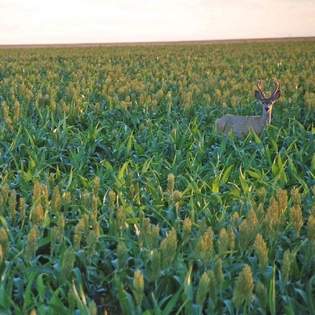
Save water, reduce risk, plant grain sorghum.
“It’s one of those ancient crops that’s being given another look,” said Jesse McCurry, a regional field representative for the National Sorghum Check-off based at Colwich, Kan. “We’ve got some encouraging signs out there.”
Sorghum acreage has been on a slight uptick lately after a downward tapering that started in the mid-1990s. According to USDA’s prospective plantings report this spring, farmers in Oklahoma, for example, intend to plant 3 percent more sorghum this year and 19 percent less corn.
That’s no surprise to seed dealers in the region.
James Wuerflein has been growing non-irrigated sorghum steadily for at least two decades in Northwest Oklahoma near Kremlin and considers it his most reliable crop. “Rotating crops is how I got into it,” he said at a sorghum meeting earlier this spring. “And over time, it’s been more profitable than anything else I’ve grown. If I look at the long-term averages, it gives me better profits than any other crop.”
Wuerflein, who is an at-large member of the U.S. Sorghum Check-off board and a Channel seed dealer, noticed early on that farmers in southwest Kansas and northwest Oklahoma were showing more interest in planting sorghum this year.
Another seed dealer, Roger Goodwin, a sales representative for Johnston’s Grain Company of Enid, also said he noticed the trend, especially in the north central Oklahoma corridor along Interstate 35.
Treat it well
One of the reasons Wuerflein believes sorghum has lost out to corn in the crop sweepstakes of recent years is that growers generally don’t manage it as aggressively as they do corn.
“Sorghum tends to be planted on marginal acres, and farmers don’t manage those acres very well,” he said. “In the yield trials, where we have optimal management, yields have been strong.”
Brian Arnall, a crop production specialist with Oklahoma State University, agrees.
“We’re under-fertilizing our milo,” he said. “ We have the genetic potential for 200-bushel milo.”
It’s not only a matter of applying nitrogen, however, but also of increasing nitrogen efficiency by managing soil for the proper pH and applying the right amount of phosphorous and potassium, Arnall said. “Improper soil pH causes dead spots and affects winter survivability for all crops except wheat and rye,” he added.
Since the national grain sorghum check-off was established in 2008, sorghum leaders have been using some of the roughly $7 million in proceeds for producer education aimed at enhancing soil fertility, pest control, weed control and other management practices.
Shake-up under way
The crop mix nationwide is undergoing a subtle shift, as economics long favorable to corn are beginning to change. This year soybeans look to be the big winner, projected to be 6 percent higher nationally with potential for a record of more than 81 million planted acres.
But in the Southern Plains, drought and chronic water shortages continue to increase the relative value of “water sipping” crops like grain sorghum.
For now, corn is still king. Farmers in both Colorado and Kansas say they intend to plant slightly more corn this year than last, if the weather permits. But in Oklahoma, farmers who tried to grow dryland corn last year experienced high levels of nitrates and aflatoxin contamination in their heat-stressed crop, which made it hard to sell or utilize.
By contrast, sorghum yields in many areas were strong — 180 bushels to the acre was fairly common — and export sales proved robust. (So far this year U.S. corn sales to China are down 85 percent, due to a trade dispute over an unapproved genetically modified trait, according to the National Grain and Feed Association.)
Local demand for grain sorghum is also a selling point. Where there is livestock production, whether cattle or hogs, sorghum typically has a strong market basis, according to Jeff Bedwell, a county extension agent based at Fairview, Okla.
Another benefit sorghum offers is planting flexibility. If the weather stays cold or wet late into the season, or if winter wheat or canola crops fail, sorghum can be planted later than virtually any other spring crop. It’s no secret the condition of the wheat crop has been in decline since last fall.
Bill Golden, a Kansas State University ag economist who is studying the riddle of how ag communities in western Kansas can maintain profitability while using less water, knows farmers tend to prefer corn, but also reminds them that grain sorghum yields are less variable under stressful conditions.
“Averages don’t tell the whole story,” he concludes. “When you consider the variability in the weather, incorporating grain sorghum in a crop mix can maintain revenues while decreasing risk.”
“Treat it well, and it pays off,” added Wuerflein, the northwest Oklahoma farmer. “But you’ve got to put money in to get money out.”
Source: Sorghum’s perks worth a look – News – LA Junta Tribune – La Junta, CO – La Junta, CO.




